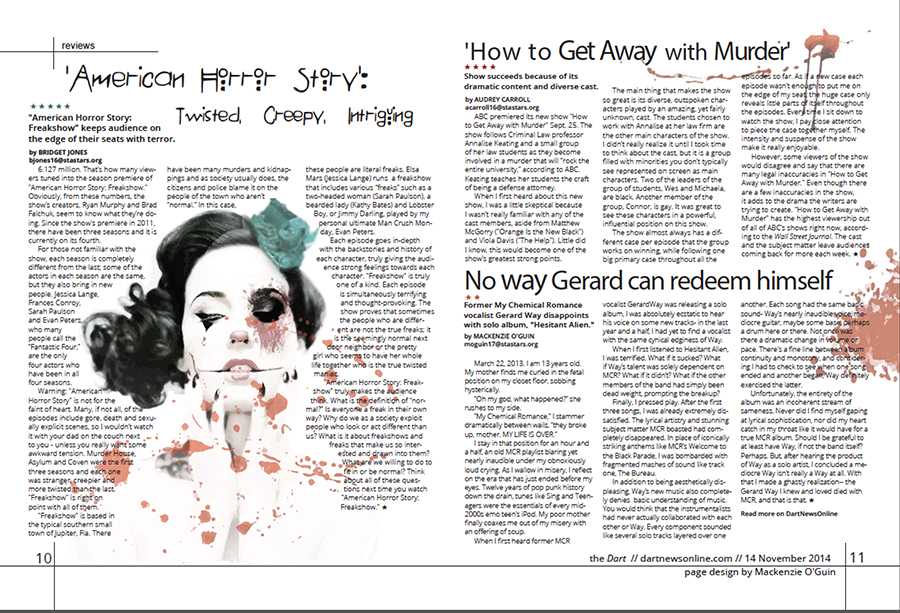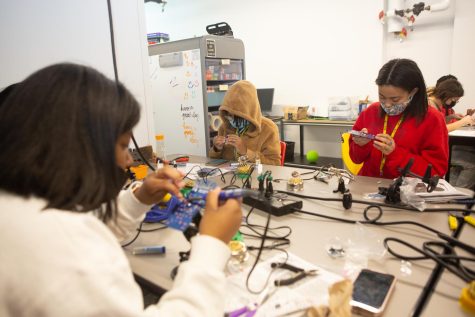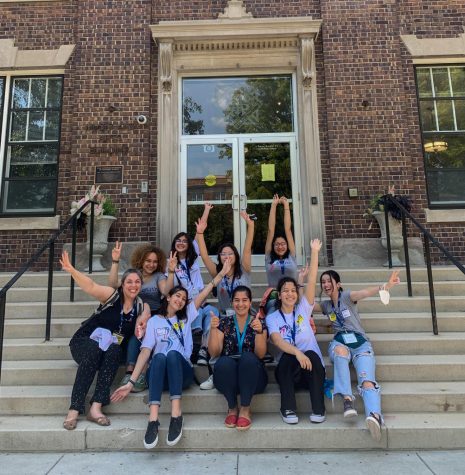Dart announces best of the year winners
At the Publication Banquet Monday, journalism teacher Brad Lewis announced the best of the year contest winners. The Dart and Teresian staffs voted on each category – photo, design, story and opinion piece. View the winners here:
May 16, 2015
Photo of the year
by Siobhan Miller

Design of the year
by Mackenzie O’Guin
Story of the year
Inmates unlock potential in design jobs
by Gloria Cowdin and Christina Elias
The two-lane Highway 5 that winds its way through the fringes of Leavenworth, Kan., seems as unassuming a road as any, bordered intermittently by cows lazily grazing and small barns. About ten minutes into the drive, however, a curve in the road and small upward incline introduce the view of the oldest and largest male detention facility in the state of Kansas: Lansing Correctional Facility.
This facility—red brick and surrounded by beautiful landscaping—is broken into three groups of buildings which house minimum, medium and maximum-security inmates. The minimum-security facility is seen first with its large outdoor yard area where inmates (wearing their standard white shirts, blue jeans and red caps) play various sports or exercise on the track. The minimum security buildings are noticeably older than the other parts of the facility, owing to the age and long history of the prison.
A short walk across the road from the minimum security facility stands a 20,000-square-foot warehouse which houses merchandise produced in separate facilities. When you first walk into the building, you are met with boxes of promotional products stacked four level high, neon green labels advertising names like Gildan and Adidas. The warehouse is fairly quiet besides the music–there are few people there, working quietly. Occasionally, you’ll hear the sound of men calling out to each other from different areas of the warehouse.
These men are inmates at Lansing Correctional Facility.
A company called Impact Design leases this warehouse from the state of Kansas and provides paying jobs to men in minimum and medium-security custody. While this warehouse is the workplace for some men, most of the 250 inmates employed by Impact work in the medium-security facility in the embroidery and screenprinting warehouses. There, employees manufacture goods that are then sold by local and national apparel distributors, like Adidas or Gildan.
Impact Design is a part of a four-part equation: the customer, the “middleman,” garment distributors and decorators. One of these middlemen is Summit Sportswear, a Kansas City-based collegiate apparel distributor. Summit sells a variety of spirit-wear products, including the uniform fleeces sold in the St. Teresa’s Academy Star Shop. The STA patches on each of these fleeces are manufactured and assembled by inmates at Lansing Correctional Facility. According to the Star Shop manager Marcia Warwick, STA has purchased items from Summit in the past, such as the auction sweatpants, and will continue to purchase the fleeces from them in upcoming school years.
“If it gives [the inmates] something that they feel good about doing and it helps everybody, then it sounds like a good thing,” Warwick said of Impact’s program at Lansing.
Vice President of Operations for Impact Design Matt Bennett is responsible for hiring the inmates, so he frequently interacts with them and remains in contact with some after their release to help them re-assimilate into society. According to Bennet, many inmates are in Lansing due to “extenuating circumstances” in their lives, which can reappear after their release and increased their likelihood of recidivism (relapse into criminal behavior). Keeping in touch with these former inmates—some of whom have never used the internet or an iPhone—helps ease readjustment into society and prevent their return.
“Because of the program and what we provide, it is a way to give back to the community,” Bennett said. “Coming here was a way of working with these guys . . . [to] help them figure out some of that stuff. I’m helping out on the front lines instead of 10,000 feet away.”
According to Bennett, employees at Impact make an hourly wage of up to $9.50, depending on their position within the company. Just under half—45 percent—of this income is used to pay the prison room, board and taxes; a chosen portion is deposited in a locked savings account, which is accessible after release; the remaining amount can be used for personal spending or to send home to families.
At Lansing, all prisoners begin in maximum-security custody and move down to minimum, depending on time, behavior and circumstances. Once an inmate is in medium-security custody, he is eligible to apply for a job with Impact Design. According to Bennett, all employees start work on the production floor and can work their way up to position in the office. Bennett estimates that there are currently 550 inmates (out of the 1,200 in minimum and maximum-security custody) on a waitlist to be hired by Impact.
“The need and the desire to work for Impact is tremendous,” Bennett explained. “It makes my guys appreciate what they have.”
Bennett says that “there is not a lot [Lansing] can do to keep the guys busy.” He says there are “not enough programs to keep those [1,800] people busy.” That’s where Impact comes in: for employees of Impact Design, the pay is better, the conditions are better, and there is a bigger opportunity to learn skills they can use after their release, he said.
In addition to the obvious benefits of working for a company like Impact, their time there offers long-term advantages as well. According to Bennett, employees at Impact have a 90 percent chance of finding a job after release and 80 percent don’t return to prison within five years, which constitutes ‘success’ according to the State of Kansas.
Another job opportunity for inmates at Lansing is to work for Kansas Correctional Industries, making street paint, working in the kitchens, doing landscaping and other odd-jobs. According to Bennett, these inmates make around $12 a month to buy all personal and hygiene items, which are sold at regular prices in the prison stores. Conversely, the experience and payment received at Impact can provide inmates with countless more opportunities for life after prison.
According to STA theology teacher Michael Sanem, types of programs like Impact in prisons are good forms of rehabilitation for inmates and help give them a sense of dignity again.
“[These programs] give them something constructive to do,” Sanem said. “They really like having jobs and they take pride in their jobs.”
Sanem volunteers on a bi-weekly basis at Lansing Correctional Facility, participating in prison ministry. That entails reading that week’s readings with the inmates, answering their questions about the readings, and giving them some type of exposure to civilians, he said. He began volunteering at Lansing about a year ago, beginning when his mother met a man named Dan Dakotas, a member of the group Sanem now volunteers with—the Bethany Group.
According to Sanem, he found out about their embroidery and screenprinting operations one day while he was visiting with medium-security custody inmates. One of the inmates, he said, mentioned that the name St. Teresa’s Academy sounded familiar to him. This man worked in the embroidery shop and had seen the STA emblem on the fleeces, one of which he showed Sanem. For some inmates at Lansing, having the opportunity to work with Impact can be life-changing.
Greg, who was incarcerated when he was 19, has been an inmate at Lansing for 21 years and worked with Impact for 15 years. He works Monday through Friday, 8:00 a.m. to 4:30 p.m. as a digitizer— meaning he converts digital files into formats the embroidery machine can read.
Like many of his co-workers, Greg never held a steady job before his conviction and time at Impact. He cites his experience at Impact as “invaluable” and plans on becoming Adobe Acrobat certified after leaving Lansing. Greg’s ultimate goal is to take classes at Johnson County Community College and become a graphic designer. To further his knowledge of graphic design, he has purchased books about computer programs with his earnings. Most of his paycheck, however, he places in a savings to use in life after prison.
“I won’t have to worry [about money] necessarily right out of the gate,” Greg said.
According to Bennett, “Having that financial stability makes a big difference” in terms of succeeding post-release. Many inmates do not have the opportunity to open a savings account or gain experience like Greg has, which leaves them virtually helpless after their release.
“[We try to] integrate them slowly back [into society],” Bennett said. “There isn’t anybody really to help them. Their world was here. And that’s the mindset they need to get away from. There’s no other support once they get out.”
Opinion of the Year
How it feels to be black
by Torie Richardson
Recently, I had a conversation with my father and another friend of our family. Though this situation was mostly a conversation (as opposed to an interrogation), the man asked me a question that made me pause: “What’s it like to be black?” He knew, of course – his skin was even darker than mine. But I think he was curious about how I would respond. I’d never really thought about it before. What is it like to be me? To be treated a certain way based on your appearance? Here is my response:
Being black means you have to sit a little straighter to be considered poised. You have to speak properly to avoid being thought of as ghetto. You have to be careful in stores, because you know people are already suspicious of your blackness, a word synonymous with “thief.”
Being black means no matter who you encounter, they will judge you for being black. God forbid your skin is darker than a Hershey’s bar or your name ends in -isha. That, of course, is nearly irredeemable.
Being black means cringing when another black person is acting foolishly, because you know it will affect the way people view you.
Feeling black means feeling underrepresented everywhere. In the media. In your country’s accounts of history. Even in your own school, where you don’t have any black teachers.
Being black means feeling at home with your white friends, but knowing that you are the odd one out when you’re together in public. That the worst thing that can happen to a white man’s son is for him to marry a black girl.
Being black means you are black, and nothing else.
It means that the color of your skin defines you.
Being black means you should be able to play basketball, and run track. It means you should have a big voice and butt to match. It means that you’re hot-tempered and may be pretty, but only “for a black girl.”
At least, that’s what I’ve been taught.
But I can’t help but feel as if there is something more. I can’t help but look at my black parents in pride. At my dad, who was the first black man to graduate from UMKC with a pharmaceutical degree. At my mom, who hates her name because she thinks it sounds ghetto, but is one of the smartest people I know.
And maybe the things I mentioned before are how it’s supposed to feel to be black. But maybe they are projections. Because when I really settle into my skin, it is powerful.
To be black means to come from a line of people who stood up for what they believed in unconditionally. Who were so smart they sang in code. It means coming from inventors, from geniuses, from hard workers.
To be black is to be different. It is not better. But, unlike what I’ve been taught from the world around me, it is not worse.
To be black is to be human.
It means you are worthy of dignity and respect.
It means you deserve a chance.
But, for some reason, my blackness seems to cover others’ eyes of the truth.
This experience is not perpetuated by one person, though. It is supported by those who laugh at stereotyping and refuse to examine their own intentions. By those who claim they are “not racist,” but continually marginalize those who are different than them. By you, reader, who think of others while reading this column, but refuse to look in the mirror.
How does it feel to be black? You decide.










